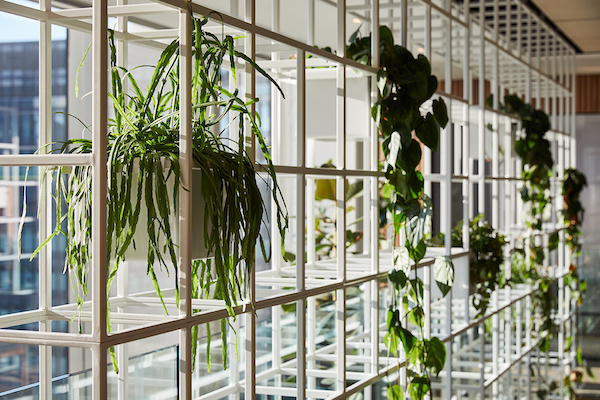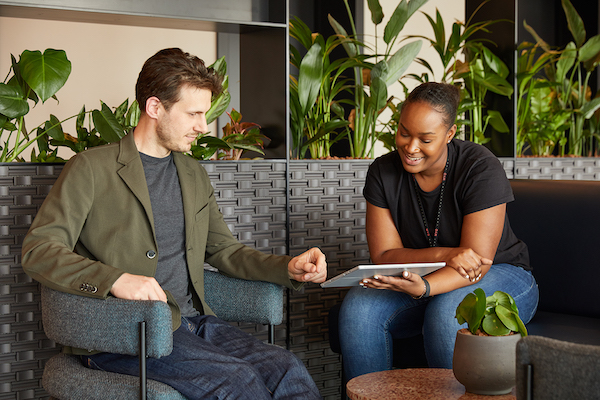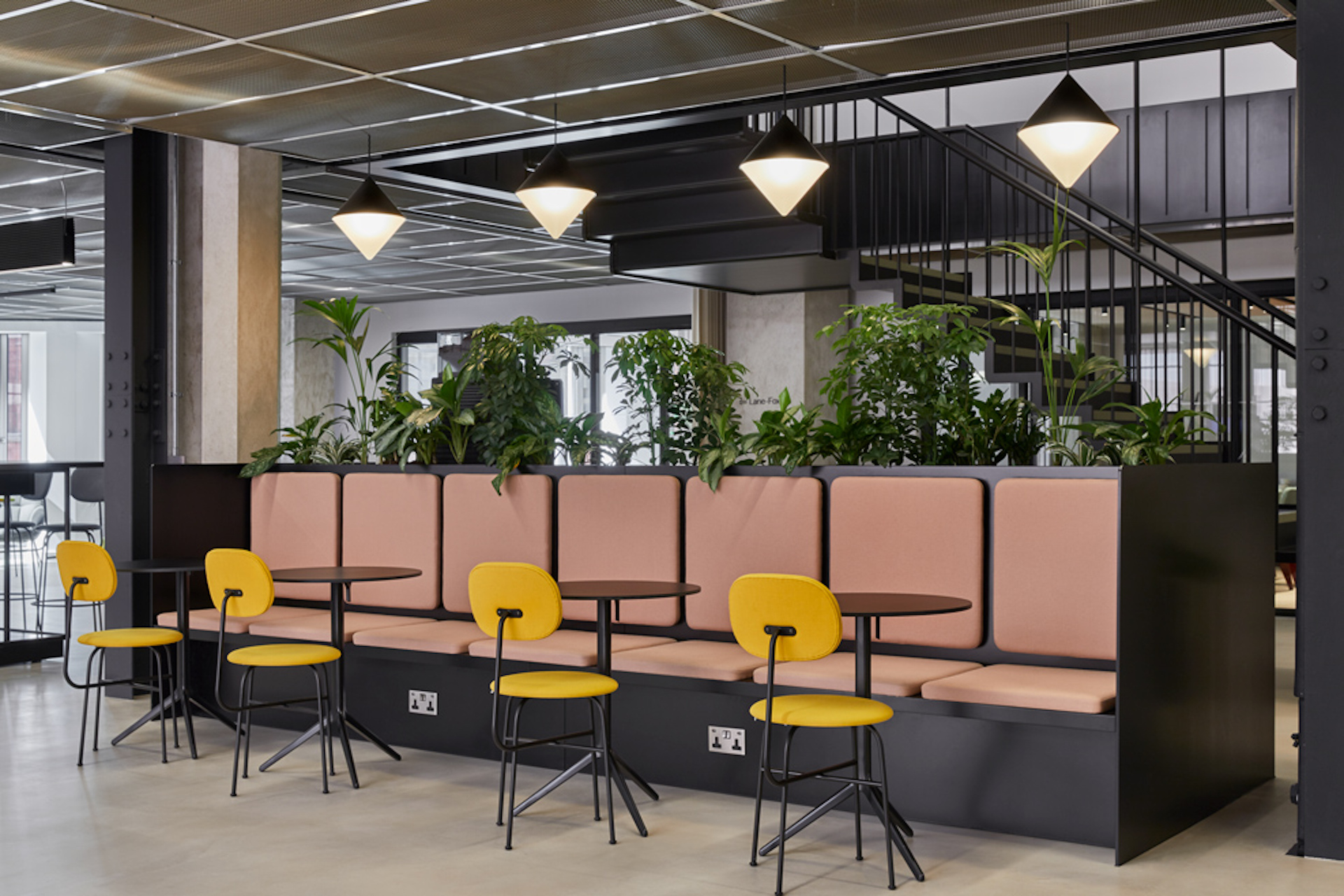In a recent survey of 2,000 UK-based office workers, it was found that 46 per cent believed the introduction of green initiatives in their workplace to be an ‘afterthought’.
For modern businesses in an increasingly environmentally conscious market, eco-friendliness can no longer afford to be an afterthought. It should be a priority. And, when you take into account the fact that 22% of employees would be influenced to accept or decline a job offer based on a company’s sustainability goals, it becomes clear why.
As more and more of us return to work, the sustainability spotlight has been turned onto the office as a place where businesses should be doing more for the planet.
What does an eco-friendly office look like?
Here at Myo, we have five distinct office rental locations in London — Bankside, New Street Square, St Paul’s, Victoria Street, and Liverpool Street, – all in Landsec-owned buildings.
When creating these unique, functional spaces, we considered the environment and sustainability at all levels — from the building’s external layout right down to its interior design.
In another of our blogs, we discuss the large-scale steps you can take towards workplace sustainability, as well as their benefits. However, for some smaller-scale actions to help you prioritise the planet in your office, read on.
1. Lighting & energy
- Has it been a while since the lights and bulbs in the office were last replaced?
- Is the current office lighting system costing a lot in energy bills?
- Do the lights in the office seem to be on all of the time?
- Are the current office lights quite dim or dark?
- Do the current overhead lights in the office have to be supplemented with standing or desk lamps?
Starting simple, let’s talk about lighting. If you’re struggling with an inefficient office lighting system, ask yourself the following questions:
If the answer to any of the above was “Yes!” It’s time to invest in a smarter, more efficient office lighting solution. In recent years, LED has transformed the way office spaces are lit, remaining the most popular lighting choice for offices across the UK in 2023. Why?
Firstly, LED bulbs consume far less energy than a regular bulb — up to 75% less, in fact — despite often being much brighter. This not only reduces your carbon footprint but your energy bills too. We’ve spoken elsewhere about the impact lighting can have on employees‘ satisfaction and productivity, too.
Secondly, if you’re looking to save money in the long run, LED bulbs have far longer life spans than regular light sources, reducing the need for regular replacement – and the hassle of correctly disposing of the old bulbs.
In terms of the office environment, LED lights are also dimmable and are easily paired with smart solutions such as sensor lighting. Sensor lights are an excellent way to reduce the amount of energy consumed, as areas in the office are only lit when motion is detected.
While we’re on the topic of energy, how energy-efficient is your office? And, where does your energy come from? The latter question is something very few workplaces consider. Myo Victoria Street, on the other hand, is not only certified BREEAM ‘Very Good’ for energy efficiency but has 100% of its electricity supplied from renewable sources.
Similar levels of efficiency have been achieved at all of our office locations — from Bankside, a carbon net-zero building, to St Paul’s, where generous natural lighting has been provided throughout with 70% of workstations offering 5m of glazing.

2. Water & recycling
As a counterpoint to electricity, considering water usage and conservation in the office is another excellent and relatively easy eco-friendly change you can make. If you have any outside space around your office or roof space, have you considered rainwater harvesting, as we do at our offices?
Due to the positive impact of biophilic design in the workplace, many offices now have plants and greenery in them which require regular watering. Collecting rainwater is a small-scale, yet effective, solution to this need.
Aside from water, is your office also actively recycling other products?
Do you have a recycling system in place for your staff to use? This may take the form of a series of ‘recycling stations’, with different-coloured bins in popular zones of the office.
If you rent an office or a floor in a larger building, do you know how they recycle? Is there more you could be doing to make sure your cans, coffee cups, and cardboard and plastic packaging aren’t just going to landfill?
Currently, at our Victoria Street offices, we have an 86% recycling rate – which is always improving. In fact, our recycling rate is high for all of our offices across the board with 80% minimum recycling targets in all of our newer locations.

3. Waste & paperlessness
Going paperless is one of the most simple ways an office can effect a positive change for the planet. What’s more, this is a change that’s gradually happening organically with the increased use of technology in the workplace.
More and more, employees rely upon emails, online chat, and electronic documents instead of post-it notes and paper copies. However tempting it may be to print out notices or documents, if a ‘culture of paperlessness’ is rolled out across an office like Myo’s it can have a huge impact.
Putting things into perspective, it is estimated that 26% of waste sent to landfill sites comes from paper and cardboard. When paper rots, methane gas is created, a gas 25 times as toxic as carbon dioxide. If you can’t avoid paper all the time, then make efforts to recycle it properly.
When it comes to waste, offices also usually have a lot of ‘specialist’ items to get rid of.
Faulty or legacy electrical goods will need to be disposed of correctly, as well as toxic chemicals from things like printer ink cartridges. As an office, in order for you to do your bit for the planet, these factors need to be carefully considered.
To shine a spotlight on this issue, approximately 45 million used printer ink cartridges are thrown away in Britain each year, the majority of which end up in landfill. They can take up to 1,000 years to decompose, all the while releasing unnecessary toxins into the soil and water supply.
There is little excuse for this as many printer ink cartridge suppliers like HP have in-store disposal services, or even mail return options. At Myo, 100% of our waste is diverted from landfill.

4. Use sustainable suppliers
When it comes to making a workplace more eco-friendly, businesses and employees tend to focus exclusively on the physical factors, looking for quick-win changes they can make, or products they can buy.
While there’s nothing wrong with this, less ‘tangible’ factors such as suppliers tend to get overlooked as a result. To be truly eco-friendly in the office, the planet should be considered at all levels, not just in the things we can see. So, when considering the services and products you have in the office, try to consider the following:
Sourcing locally
Global shipping is responsible for 3% of greenhouse gas emissions worldwide. Are you unnecessarily shipping products from overseas that could be sourced closer to home?
Seasonality
Similarly to the above, if you have a catered office, are the food options available in line with what’s grown seasonally? By relying upon local produce, you can massively reduce your carbon footprint in terms of shipping emissions and contribute to the local economy.
Using the coffee we supply in our serviced offices as an example, let’s hone in on what a sustainable supply chain could look like from bean to cup to office.
Round the corner from our Victoria Street offices is a coffee shop called Change Please. In a unique business model, this organisation trains homeless people to be baristas and serves delicious coffee to Londoners – with 100% of the profits going towards helping the homeless.
Change Please is the supplier of coffee to both of our serviced offices. We are happy to support them as their coffee is 100% Arabica & Rainforest Alliance certified, and made using sustainable farming practices that don’t damage the land.
Still not convinced? If the environmental benefits alone weren’t enough, it is worth considering that 83% of UK adults are more likely to interact with businesses that source their products locally, and 55% would pay more for ethically-sourced goods.
So, the next time you make an order or recurring purchase for the office, think about where it came from and who was involved.
5. Carbon offsetting
Lastly, a slightly larger-scale method of making an office more eco-friendly is carbon offsetting. This refers to the practice of compensating for your carbon emissions by facilitating carbon sequestering elsewhere.
For many businesses, this involves a financial element in the form of funding or sponsoring projects that sequester carbon. But for us at Myo, we prefer to do things our own way.
Our Victoria Street office, for example, has not one but two ‘green’ roofs covered in plants that absorb the CO2 in the air from the emissions around them. Book yourself onto a tour and see them for yourself.
Office spaces that don’t cost the earth
We hope you feel ready to make some planet-positive changes around your workplace after reading this. For more office-based advice or inspiration, be sure to keep up with our blog. Or, to find out more, download a brochure for either of our locations.
If you’d like to discuss any of our eco-friendly office innovations, contact one of our team by email at [email protected] or call us on +44(0)20 3876 6690.



